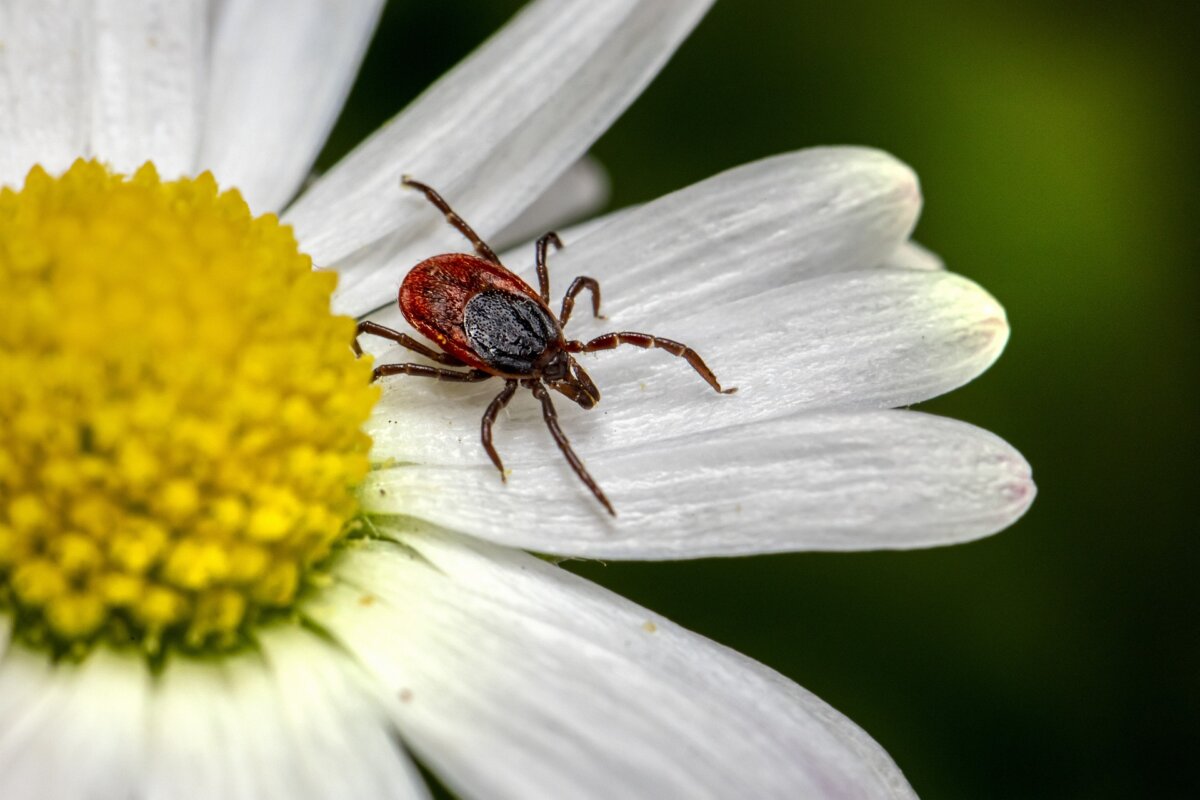The Hessian areas south of the Main have been among the risk areas for tick-borne TBE for some time. In Offenbach there were four reported cases of TBE between 2016 and 2022. But not only TBE is transmitted by ticks, another, much more common disease is Lyme disease.
The Offenbach City Health Office provides information about ticks and the diseases they can transmit and gives tips on how to protect yourself.
What are ticks?
Ticks are arachnids and are blood-sucking parasites. Different species live in Germany. The most common tick is the wood tick (Ixodes ricinus).
Unlike humans and mammals, ticks develop through stages that vary in appearance, from the smaller juvenile stages (larva and nymph) to the larger, adult ticks (female and male). The number three is important for further development: three blood meals on three different hosts such as mice, cats, dogs or humans are required. In some species, the process can even take years.
Where are ticks found?
In Germany, ticks can be found in all areas up to an altitude of around 2,000 meters in the wild (forest, bushes, meadows), but also in inner-city parks and gardens.
What time of year are ticks active?
Ticks become active from an outside temperature of around 8 degrees Celsius and bite mainly in the morning and early evening. The actual “tick season” is from March to October.
How do ticks find their meal?
The ticks sitting in the grass and on leaves recognize possible victims by vibrations, body heat and scents. Passing people and animals brush off the ticks. So don’t let them fall from the trees.
Do ticks prefer certain parts of the body?
Ticks look for a favorable bite site for blood sucking. These are in particular body regions such as the back of the knee, groin, armpit or hairline, i.e. warm and humid areas.
What diseases are transmitted by ticks?
In Germany, ticks can mainly transmit two diseases:
Lyme disease, a bacterial disease that can be treated with appropriate antibiotics.
TBE, abbreviation for tick-borne encephalitis, a meningitis and viral disease, vaccination is possible.
If I find a tick on my body, when and how should I remove it?
A tick that is still wandering can simply be removed by hand. The tick, on the other hand, cannot defend itself by biting, because the tick needs time to saw through the skin.
A tick that has been sucked in should always be removed as soon as possible after it is discovered using tweezers or a tick card or pliers, or if none of these tools are available, with your fingertips. This is done by grasping the body of the tick as close to the skin as possible, carefully loosening it and slowly pulling it away from the bite site. The tick must not be squeezed, otherwise its infectious secretions can get into the human body. The use of “home remedies” such as oil, nail polish or glue is absolutely to be avoided. If possible, disinfect the sting site afterwards, for example with high-proof alcohol.
How can I dispose of the tick?
It should be ensured that the tick is safely killed. The use of at least 40 percent alcohol or disinfectants is suitable for this. A particularly effective method is crushing with an object. To do this, the tick should be folded into paper so that you can run a glass of water over the paper with enough pressure. Trampling with shoes is unsuitable, since a hard shield protects the animals. Flushing down the toilet is not recommended as the animals can survive in the water for up to three weeks. Disposal in the washing machine does not work either, as the animals even survive a wash cycle at 40 degrees and a spin cycle.
How can I protect myself from ticks?
Ticks are part of our biological environment. The best protection against TBE disease is preventive vaccination.
If you are outdoors, especially when roaming through the undergrowth or a meadow area, you should wear light-colored clothing (ticks on clothing are easier to see) that completely cover the body – as well as sturdy shoes. In addition, tick-repellent skin protection products can be used, but they only have limited effectiveness. Even with long clothing, the most important measure must not be forgotten: after spending time outdoors, the whole body, shoes and clothing should be thoroughly checked for ticks. Because the ticks walk along the clothing on the way home, for example, to find a free patch of skin.
Ticks do not like direct sunlight. People who prefer to roam the meadows barefoot and/or in short skirts or trousers should know that the ticks usually continue to look for a suitable spot for a while. As long as they are still migrating along the skin, they can be easily removed. However, they like to prefer places like the back of their knees, which can only be seen with a helper or in a mirror, or the groin region, where they hide under clothing. Humans do not notice the bite of the tick because it has an anesthetic.
Ticks can also occur in your own garden, since animals living there such as mice, hedgehogs, dogs or cats are also infested by ticks and a saturated tick falling into the garden can release thousands of offspring.
Therefore, pets should also be checked for ticks after their stay and the ticks should be removed so that the ticks do not fall into the garden. Ticks like it moist and shady, so it helps to keep the lawn in the garden short.
(Text: PM City of Offenbach)
#Protection #ticks #green #spaces #garden #Rhein #Main #Verlag


